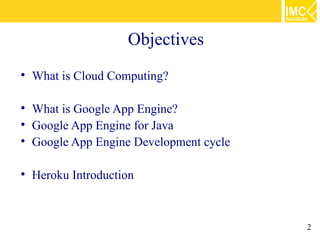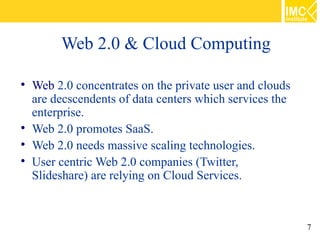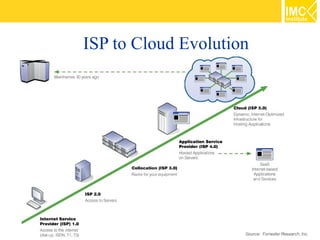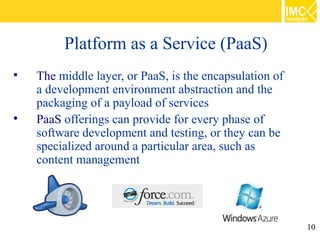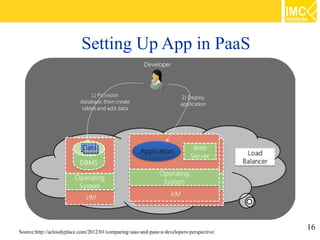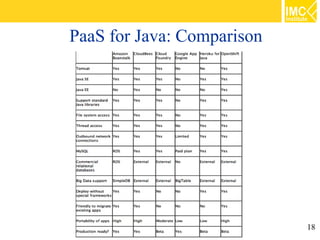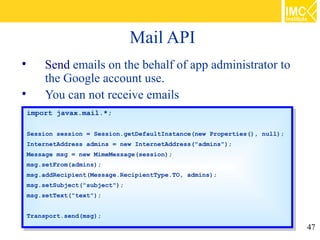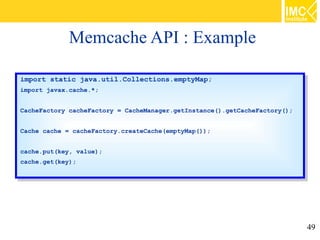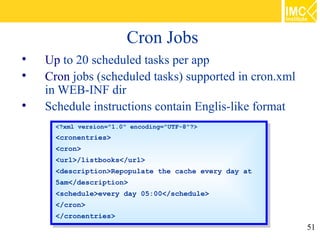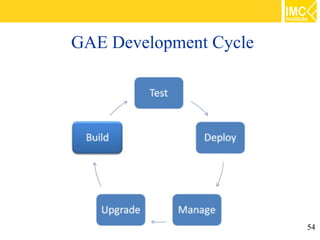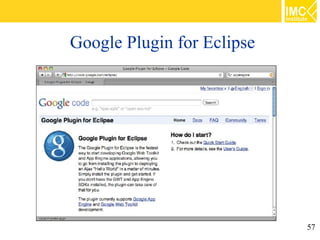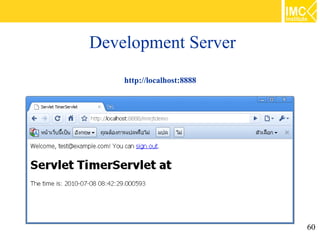Java Web Programming Using Cloud Platform: Module 10
- 1. Module 10: Java Cloud Platform Dr.Thanachart Numnonda Dr.Thanisa Kruawaisayawan www.imcinstitute.com 18-22 February 2013
- 2. Objectives What is Cloud Computing? What is Google App Engine? Google App Engine for Java Google App Engine Development cycle Heroku Introduction 2
- 3. What is Cloud Computing? 3
- 4. Cloud Computing : Definition (Wikipedia) Cloud Computing is Internet-based computing, whereby shared resources, software, and information are provided to computers and other devices on demand, like the electricity grid. 4
- 5. Cloud Computing Characteristics Massive, abstracted infrastructure Dynamic allocation, scaling, movement of applications Pay per use No long-term commitments OS, application architecture independent No hardware or software to install 5
- 6. Grid to Cloud Evolution 6
- 7. Web 2.0 & Cloud Computing Web 2.0 concentrates on the private user and clouds are decscendents of data centers which services the enterprise. Web 2.0 promotes SaaS. Web 2.0 needs massive scaling technologies. User centric Web 2.0 companies (Twitter, Slideshare) are relying on Cloud Services. 7
- 8. ISP to Cloud Evolution 8
- 9. Software as a Service (SaaS) SaaS is at the highest layer and features a complete application offered as a service, on- demand, via multitenancy — meaning a single instance of the software runs on the provider’s infrastructure and serves multiple client organizations. 9
- 10. Platform as a Service (PaaS) The middle layer, or PaaS, is the encapsulation of a development environment abstraction and the packaging of a payload of services PaaS offerings can provide for every phase of software development and testing, or they can be specialized around a particular area, such as content management 10
- 11. Infrastructure as a Service (IaaS) IaaS is at the lowest layer and is a means of delivering basic storage and compute capabilities as standardized services over the network. Servers, storage systems, switches,routers, and other systems are pooled (through virtualization technology, for example) to handle specific types of workloads — from batch processing to server/storage augmentation during peak loads. 11
- 12. 12
- 13. Deployment Model Public Cloud: provider refers to the cloud platform that targets any types of customers. Private Cloud: infrastructure that’s hosted internally, targeting specific customers or sometimes exclusively within an organization. Hybrid Cloud: the combination of public and private clouds, or sometimes on-premise services. 13
- 14. IaaS & PaaS: Developer's Perspectives IaaS normally provides up to O/S level as your choice; for example Amazon Web Services (AWS) offers several types of Operating Systems such as Windows Server, Linux SUSE, and Linux Red Hat. Developer need to install own middleware, database, etc. PaaS, given that the database server, VM, and web server VM are readily provisioned, 14
- 15. Setting Up App in IaaS Source:http://acloudyplace.com/2012/01/comparing-iaas-and-paas-a-developers-perspective/ 15
- 16. Setting Up App in PaaS Source:http://acloudyplace.com/2012/01/comparing-iaas-and-paas-a-developers-perspective/ 16
- 17. PaaS for Java Amazon Elastic Beanstalk CloudBees Cloud Foundry Google App Engine Heroku for Java Red Hat OpenShift 17
- 18. PaaS for Java: Comparison 18
- 19. PaaS for Java: Comparison 19
- 20. What is Google App Engine? 20
- 21. Google App Engine : Definition (Wikipedia) It is a platform for hosting web applications in Google- managed data centers. It is cloud computing technology which virtualizes applications across multiple servers and data centers. 21
- 22. Google App Engine Running your web application in Google infrastructure Support different runtime environments Java (JRE 6 with limitation, Servlet 2.5, JDO, JPA) Python (2.5.2) Apps run in sandbox. Automatic scaling and load balancing No server restart, no network issues 22
- 23. Hosting Java web apps traditionally Not so popular except enterprise High rates as compared to PHP hosting Shared Tomcat instance among users Restrictions on any time deployments due to shared server Dedicated hosts works fine but they are costly 23
- 24. You end up with all this 24
- 25. 25
- 26. Google Datacenters at Dallas, Oregon 26
- 27. GAE Architecture 27
- 28. GAE Physical Deployment Diagram 28
- 29. Architecture : Application Server 29
- 30. Distributed web hosting platform 30
- 31. Distributed Datastore 31
- 32. Distributed memcache 32
- 33. Specialized services 33
- 34. Google Apps + your apps 34
- 35. Google App Engine for Java 35
- 36. GAE/J Was released on April 08 with Python support. Java included on August 09 36
- 37. App Engine for Java : One Year Source: What’s Hot in Java for App Engine Google Con 2010 37
- 38. GAE Java Runtime Environment Java 6 VM Servlet 2.5 Container HTTP Session support (need to enable explicitly) JDO/JPA for Datastore API JSR 107 for Memcache API javax.mail for Mail API javax.net.URLConnection for URLFetch API 38
- 39. Java Standards on GAE 39
- 40. Services by App Engine Memcache API – high performance in-memory key-value cache Datastore – database storage and operations URLFetch – invoking external URLs Mail – sending mail from your application Task Queues – for invoking background processes Images – for image manipulation Cron Jobs – scheduled tasks on defined time User Accounts – using Google accounts for authentication 40
- 41. Limitations Programming Model : Application runs in sandbox and can not – Write to file system – Make arbitrary network connections – Use multiple threads/processes – Perform long-lasting processing – Permissions – Know about other instances/applications Quotas (Requests, In/Out bandwidth, CPU time, API calls) 41
- 42. GAE Datastore 42
- 43. GAE Datastore Storing data and manipulation Based on Bigtable Bigtable is proprietary and hidden from the app developers Not a relational database (No SQL) GQL (Google Query Language) to query Stores data as entities Distribution, replication, load balancing behind the scene Need to use JDO/JPA 43
- 44. User Service : Google Accounts Google Accounts are encouraged as the preferred authentication mechanism for App Engine – It assumes that all users have a Google Account – Google authentication for private domains isn’t available yet Access to Google account data -> email, id The Development Server simulates Google Accounts Access constraints based on roles 44
- 45. User API : Example import com.google.appengine.api.users.*; import com.google.appengine.api.users.*; UserService userService == UserServiceFactory.getUserService(); UserService userService UserServiceFactory.getUserService(); User user == userService.getCurrentUser(); User user userService.getCurrentUser(); String navBar; String navBar; if (user == null) {{ if (user == null) navBar == "<p>Welcome! <a href="" ++ userService.createLoginURL("/") navBar "<p>Welcome! <a href="" userService.createLoginURL("/") +"">Sign in or register</a> to customize.</p>"; +"">Sign in or register</a> to customize.</p>"; }} else {{ else navBar == "<p>Welcome, "" ++ user.getEmail() ++ "! You can <a href="" navBar "<p>Welcome, user.getEmail() "! You can <a href="" +userService.createLogoutURL("/") +"">sign out</a>.</p>"; +userService.createLogoutURL("/") +"">sign out</a>.</p>"; }} 45
- 46. URLFetch API Invoking external URLs from your application over HTTP and HTTPs import java.net.*; import java.net.*; import java.io.*; import java.io.*; URL url == new URL("htp://..."); URL url new URL("htp://..."); InputStream inp == new InputStreamReader(url.openStream()); InputStream inp new InputStreamReader(url.openStream()); BufferedReader reader == new BufferedReader(inp); BufferedReader reader new BufferedReader(inp); String line; String line; while ((line == reader.readLine()) != null) {{ while ((line reader.readLine()) != null) //do something //do something }} reader.close(); reader.close(); 46
- 47. Mail API Send emails on the behalf of app administrator to the Google account use. You can not receive emails import javax.mail.*; import javax.mail.*; Session session == Session.getDefaultInstance(new Properties(), null); Session session Session.getDefaultInstance(new Properties(), null); InternetAddress admins == new InternetAddress("admins"); InternetAddress admins new InternetAddress("admins"); Message msg == new MimeMessage(session); Message msg new MimeMessage(session); msg.setFrom(admins); msg.setFrom(admins); msg.addRecipient(Message.RecipientType.TO, admins); msg.addRecipient(Message.RecipientType.TO, admins); msg.setSubject("subject"); msg.setSubject("subject"); msg.setText("text"); msg.setText("text"); Transport.send(msg); Transport.send(msg); 47
- 48. Memcache Service Distributed in memory cache, better than DataStore Key-value pair mapping Configurable expiration time but Unreliable might be vanished at any time Supported Interfaces : – JACHE (JSR 107: JCACHE – Java Temporary Caching API) – The Low-Level Memcache API 48
- 49. Memcache API : Example import static java.util.Collections.emptyMap; import static java.util.Collections.emptyMap; import javax.cache.*; import javax.cache.*; CacheFactory cacheFactory == CacheManager.getInstance().getCacheFactory(); CacheFactory cacheFactory CacheManager.getInstance().getCacheFactory(); Cache cache == cacheFactory.createCache(emptyMap()); Cache cache cacheFactory.createCache(emptyMap()); cache.put(key, value); cache.put(key, value); cache.get(key); cache.get(key); 49
- 50. Task Queues API Perform background processes by inserting tasks into queues. Instructions need to be mention in file queue.xml, in the WEB-INF/ dir import com.google.appengine.api.labs.taskqueue.Queue; import com.google.appengine.api.labs.taskqueue.Queue; import com.google.appengine.api.labs.taskqueue.QueueFactory; import com.google.appengine.api.labs.taskqueue.QueueFactory; import com.google.appengine.api.labs.taskqueue.TaskOptions; import com.google.appengine.api.labs.taskqueue.TaskOptions; // ... // ... TaskOptions taskOptions == TaskOptions taskOptions TaskOptions.Builder.url("/send_invitation_task") TaskOptions.Builder.url("/send_invitation_task") .param("address", "[email protected]") .param("address", "[email protected]") .param("firstname", "Juliet"); .param("firstname", "Juliet"); Queue queue == QueueFactory.getDefaultQueue(); Queue queue QueueFactory.getDefaultQueue(); queue.add(taskOptions); queue.add(taskOptions); 50
- 51. Cron Jobs Up to 20 scheduled tasks per app Cron jobs (scheduled tasks) supported in cron.xml in WEB-INF dir Schedule instructions contain Englis-like format <?xml version="1.0" encoding="UTF-8"?> <?xml version="1.0" encoding="UTF-8"?> <cronentries> <cronentries> <cron> <cron> <url>/listbooks</url> <url>/listbooks</url> <description>Repopulate the cache every day at <description>Repopulate the cache every day at 5am</description> 5am</description> <schedule>every day 05:00</schedule> <schedule>every day 05:00</schedule> </cron> </cron> </cronentries> </cronentries> 51
- 52. Images API Manipulation of images Transformation of images Changing image formats 52
- 53. GAE Development Cycle 53
- 54. GAE Development Cycle 54
- 55. Getting Started The application owner must have a Google Account to get the tools regardless of language. Use Java 6 for development. Eclipse and Netbeans have official plugins. Both SDKs ship with a Development Web Server that runs locally and provides a sandbox almost identical to the real run-time. 55
- 56. Software Development Kit App Engine SDK – Includes web server (Jetty) – Emulates all the GAE services SDK includes an upload tool to deploy app to GAE Command line tools included. 56
- 57. Google Plugin for Eclipse 57
- 58. Development Environment Development Server Application lifecycle management Eclipse/NetBeans plugins / Firefox plugin (GWT) 58
- 59. Google Plugin for Eclipse 59
- 60. Development Server http://localhost:8888 60
- 61. Development Server Admin Console http://localhost:8888/_ah/admin 61
- 62. Deployment Environment Application is deployed as .war which contains. Deployment is integrated in IDE Deploy multiple version of the application at the same time Your app lives at – <app_id>.appspot.com or – Custom domain with Google Apps 62
- 63. Running your app on Google http://<version>.<appid>.appspot.com/some/path 63
- 64. Managing Applications Administration Console http://appengine.google.com/a/yourdomain.com Application Dashboard Multiple application versions Analyzing log files (including admin) Analyzing resource usage 64
- 65. GAE Dashboard 65
- 66. 66
- 67. Heroku Platform as a Service for professional apps developers Forget servers Run anything See everything Trust & Managed 67
- 68. Forget Servers Agile deployment for Ruby, Node.js, Clojure, Java, Python, and Scala. 68
- 69. 69
- 70. 70
- 71. Resources Google App Engine at a glance, Stefan Christoph Developing Java Based Web Applications in Google App Engine, Tahir Akram, Dec. 2009 Google App Engine, Patrick Chanezon, Mar 2010 71
- 72. Thank you [email protected] www.facebook.com/imcinstitute www.imcinstitute.com 72


